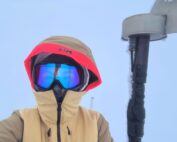Observing the Boundary Layer From Atop New England
2015-01-10 20:22:07.000 – Michael Wessler, Summit Intern
There are few things that have the power of hands-on learning. As a student in the field of Meteorology, a lot of time is spent in lectures and labs, or analyzing data in front of a computer. While there is real value in this learning, the classroom can only get you so far. When I step out onto the windswept observation deck and into the elements, I’m able to give meaning to all the coursework I have done so far.
My experience on the summit has given me a unique experience to reside above the Planetary Boundary Layer. For the most part, we all exist within the boundary layer, the lowest 300-3000 meters of the atmosphere. In this layer we experience rapid temperature change with the rise and set of the sun, turbulent rising air causing cloud formation, and often, the majority of the moisture in a column of air.
In a rare afternoon of clearing my last shift, beautiful waves rippled through the sea of clouds filling the horizon to the west. Triggered by turbulence and kept under a region of high pressure, these waves propagate over long distances under the stable ‘cap’ at the top of the boundary layer. To be able to look down at the very phenomena I am studying in the office downstairs is awe-inspiring. In addition, how dry the air can be above the boundary layer is impressive. It’s not every day you see a ‘surface’ station observe a dew point temperature near -45F!
Living above the boundary layer, to de-icing instruments on the tower, or watching inches of rime accumulate in only an hour, are only a few of the many learning experiences I’ve had at the summit these past two weeks. There really is nothing like being immersed in the elements at the Observatory, and I truly value my time spent here.
Michael Wessler, Summit Intern
Supporter Spotlight: Ryan Shepard
Supporter Spotlight: Ryan Shepard By Ryan Shepard and Carissa Milliman Ever since I was a kid, living in Western New York and growing up with lake effect snow, I thought harsh weather was incredibly
Supporter Spotlight: Erik Rider
Supporter Spotlight: Erik Rider By Wendy Almeida For Erik Rider, supporting Mount Washington Observatory comes from a lifelong fascination with weather and how it shapes daily life. Growing up along the Massachusetts coast, he
An Autumn Above the Clouds on Mount Washington
An Autumn Above the Clouds on Mount Washington By Cassie Farnsworth I don’t know how many times in life you get to say “it was exactly what I hoped it would be,” but my


